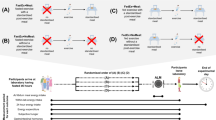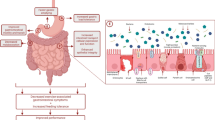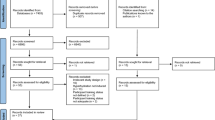Abstract
Background
Gastric emptying (GE) could influence exercise-induced changes in appetite and energy intake. GE also could contribute to changes in gastric symptoms and the availability of nutrients during exercise, which will subsequently affect performance.
Objective
The objective of this review was to determine the effects of acute exercise on GE using a systematic review and meta-analysis. The most common parameters to determine GE were selected, consisting of half-emptying time and volume emptied. Oral-caecal transit time (OCTT) was also examined.
Data Sources
Research databases (PubMed, Scopus, Google Scholar, EBSCOhost, SPORTDiscus) were searched through November 2013 for original studies, abstracts, theses and dissertations that examined the influence of acute exercise on GE.
Study Selection
Studies were included if they evaluated GE or OCTT during and/or after exercise and involved a resting control trial.
Study Appraisal and Synthesis
Initially, 195 studies were identified. After evaluation of study characteristics and quality and validity, data from 20 studies (35 trials) involving 221 participants (157 men; 52 women; 12 unknown) were extracted for meta-analysis. Random-effects meta-analyses were utilised for the three main outcome variables, and effect sizes (ES) are reported as Hedge’s g due to numerous small sample sizes.
Results
Random-effects modelling revealed non-significant and small/null main effect sizes for volume emptied (ES = 0.195; 95 % CI −0.25 to 0.64), half-time (ES = −0.109, 95 % CI −0.66 to 0.44) and OCTT (ES = 0.089; 95 % CI −0.64 to 0.82). All analyses exhibited significant heterogeneity and numerous variables moderated the results. There was a dose response of exercise intensity; at lower intensities GE was faster, and at high exercise intensities GE was slower. Walking was associated with faster GE and cycling with slower GE. Greater volume of meal/fluid ingested, higher osmolality of beverage and longer exercise duration were also associated with slower GE with exercise.
Limitations
The major limitation is that the majority of studies utilised a liquid bolus administered pre-exercise to determine GE; the relationship to post-exercise appetite and energy intake remains unknown. Study populations were also generally active or trained individuals. Furthermore, our review was limited to English language studies and studies that utilised resting control conditions.
Conclusions
These results suggest that exercise intensity, mode, duration and the nature of meal/fluid ingested all influence GE during and after acute exercise. The relationship of GE parameters with appetite regulation after exercise remains largely unexplored. Further integrative studies combining GE and alterations in gut hormones, as well as in populations such as overweight and obese individuals are needed.





Similar content being viewed by others
References
Coulton GG. From St Francis to Dante: a translation of all that is of primary interest in the chronicle of the Franciscan Salimbene:1221–1288. London: David Nutt; 1906.
Mayer J, Roy P, Mitra KP. Relation between caloric intake, body weight, and physical work: studies in an industrial male population in West Bengal. Am J Clin Nutr. 1956;4(2):169–75.
Schubert MM, Desbrow B, Sabapathy S, et al. Acute exercise and subsequent energy intake: a meta-analysis. Appetite. 2012;63:92–104.
Hopkins M, King NA, Blundell JE. Acute and long-term effects of exercise on appetite control: Is there any benefit for weight control? Curr Opin Clin Nutr Metab Care. 2010;13(6):635–40.
King NA, Tremblay A, Blundell JE. Effects of exercise on appetite control: implications for energy balance. Med Sci Sports Exerc. 1997;29(8):1076–89.
King NA, Burley VJ, Blundell JE. Exercise-induced suppression of appetite: effects on food intake and implications for energy balance. Eur J Clin Nutr. 1994;48:715–24.
King NA, Blundell JE. High-fat foods overcome the energy expenditure induced by high-intensity cycling or running. Eur J Clin Nutr. 1995;49(2):114–23.
Broom DR, Batterham RL, King JA, et al. Influence of resistance and aerobic exercise on hunger, circulating levels of acylated ghrelin, and peptide yy in healthy males. Am J Physiol Regul Integr Comp Physiol. 2009;296(1):R29–35.
Broom DR, Stensel DJ, Bishop NC, et al. Exercise-induced suppression of acylated ghrelin in humans. J Appl Physiol. 2007;102(6):2165–71.
Donnelly JE, Herrmann SD, Lambourne K, et al. Does increased exercise or physical activity alter ad-libitum daily energy intake or macronutrient composition in healthy adults? A systematic review. PLoS One. 2014;9(1):e83498.
Larson-Meyer DE, Palm S, Bansal A et al. Influence of running and walking on hormonal regulators of appetite in women. J Obes. 2012; 15 pages. doi:10.1155/2012/730409. Article ID 730409.
Thompson D, Wolfe L, Eikelboom R. Acute effects of exercise intensity on appetite in young men. Med Sci Sports Exerc. 1988;20(3):222.
Finlayson G, Bryant E, Blundell JE, et al. Acute compensatory eating following exercise is associated with implicit hedonic wanting for food. Physiol Behav. 2009;97(1):62–7.
Hopkins M, Blundell JE, King NA. Individual variability in compensatory eating following acute exercise in overweight and obese women. Br J Sports Med. 2013. [Epub Ahead of Print]. doi:10.1136/bjsports-2012-091721.
Martins C, Morgan LM, Bloom SR, et al. Effects of exercise on gut peptides, energy intake and appetite. J Endocrinol. 2007;193:251–8.
Schubert MM, Sabapathy S, Leveritt M, et al. Acute exercise and hormones related to appetite regulation: A meta-analysis. Sports Med. 2014;44(3):387–403.
Holst JJ. The physiology of glucagon-like peptide 1. Physiol Rev. 2007;87(4):1409–39.
Kojima M, Kangawa K. Ghrelin: structure and function. Physiol Rev. 2005;85(2):495–522.
Kojima S, Ueno N, Asakawa A, et al. A role for pancreatic polypeptide in feeding and body weight regulation. Peptides. 2007;28(2):459–63.
Simpson K, Parker J, Plumer J, et al. CCK, PYY and PP: the control of energy balance. Handb Exp Pharmacol. 2012;209:209–30.
Stanley S, Wynne K, McGowan B, et al. Hormonal regulation of food intake. Physiol Rev. 2005;85(4):1131–58.
Wynne K, Stanley S, McGowan B, et al. Appetite control. J Endocrinol. 2005;184(2):291–318.
Delhanty PJ, Neggers SJ, van der Lely AJ. Mechanisms in endocrinology: ghrelin: the differences between acyl- and des-acyl ghrelin. Eur J Endocrinol. 2012;167(5):601–8.
Horner KM, Byrne NM, Cleghorn GJ, et al. The effects of weight loss strategies on gastric emptying and appetite control. Obes Rev. 2011;12(11):935–51.
Levin F, Edholm T, Schmidt PT, et al. Ghrelin stimulates gastric emptying and hunger in normal-weight humans. J Clin Endocrinol Metab. 2006;91(9):3296–302.
Heath R, Jones R, Frayn K, et al. Vagal stimulation exaggerates the inhibitory ghrelin response to oral fat in humans. J Endocrinol. 2004;180(2):273–81.
Blom WAM, Lluch A, Vinoy S, et al. Effects of gastric emptying on the postprandial ghrelin response. Am J Physiol Endocrinol Metab. 2006;290(2):389–95.
Camilleri M. Peripheral mechanisms in the control of appetite and related experimental therapies in obesity. Regul Pept. 2009;156(1–3):24–7.
Cammack J, Read NW, Cann PA, et al. Effect of prolonged exercise on the passage of a solid meal through the stomach and small intestine. Gut. 1982;23:957–61.
Wang Y, Kondo T, Suzukamo Y, et al. Vagal nerve regulation is essential for the increase in gastric motility in response to mild exercise. Tohoku J Exp Med. 2010;222(2):155–63.
De Schepper HU, Cremonini F, Chitkara D, et al. Assessment of gastric accommodation: Overview and evaluation of current methods. Neurogastroenterol Motil. 2004;16(3):275–85.
Janssen P, Vanden Berghe P, Verschueren S, et al. Review article: the role of gastric motility in the control of food intake. Aliment Pharmacol Ther. 2011;33(8):880–94.
Maughan RJ. Fluid and electrolyte loss and replacement in exercise. J Sports Sci. 1991;9:117–42.
Rehrer NJ, Beckers E, Brouns F, et al. Exercise and training effects on gastric emptying of carbohydrate beverages. Med Sci Sports Exerc. 1989;21:540–9.
Rehrer NJ, Beckers EJ, Brouns F, et al. Effects of dehydration on gastric emptying and gastrointestinal distress while running. Med Sci Sports Exerc. 1990;22:790–5.
Brouns F, Beckers E. Is the gut an athletic organ? Digestion, absorption and exercise. Sports Med. 1993;15:242–57.
Moses F, Ryan C, DeBolt J, et al. Oral cecal transit time during a two hour run with ingestion of water or glucose polymer. Am J Gastroenterol. 1988;83:1055.
Peters HP, De Vries WR. Potential benefits and hazards of physical activity and exercise on the gastrointestinal tract. Gut. 2001;48(3):435–9.
de Oliveira EP, Burini RC. The impact of physical exercise on the gastrointestinal tract. Curr Opin Clin Nutr Metab Care. 2009;12(5):533–8.
Hellenbrandt FA, Tepper RH. Studies on the influence of exercise on the digestive work of the stomach. Its effect on emptying time. Am J Physiol. 1934;107:355–63.
Fordtran JS, Saltin B. Gastric emptying and intestinal absorption during prolonged severe exercise. J Appl Physiol Respir Environ Exerc Physiol. 1967;23(3):331–5.
Ramsbottom SJ, Hunt JN. Effect of exercise on gastric emptying and gastric secretion. Digestion. 1974;10:1–8.
Neufer PD, Young AJ, Sawka MN. Gastric emptying during walking and running: effects of varied exercise intensity. Eur J Appl Physiol Occup Physiol. 1989;58:440–5.
Marzio L, Formica P, Fabiani F, et al. Influence of physical activity on gastric emptying of liquids in normal human subjects. Am J Gastroenterol. 1991;86(10):1433–6.
Leiper JB, Broad NP, Maughan RJ. Effect of intermittent high-intensity exercise on gastric emptying in man. Med Sci Sports Exerc. 2001;33(8):1270–8.
Leiper JB, Nicholas CW, Ali A, et al. The effect of intermittent high-intensity running on gastric emptying of fluids in man. Med Sci Sports Exerc. 2005;37(2):240–7.
Neufer PD, Costill DL, Fink WJ, et al. Effects of exercise and carbohydrate composition on gastric emptying. Med Sci Sports Exerc. 1986;18(6):658–62.
Costill DL, Saltin B. Factors limiting gastric emptying during rest and exercise. J Appl Physiol. 1974;37:679–83.
Feldman M, Nixon JV. Effect of exercise on postprandial gastric secretion and emptying in humans. J Appl Physiol. 1982;53:851–4.
van Rosendal SP, Osborne MA, Fassett RG, et al. Guidelines for glycerol use in hyperhydration and rehydration associated with exercise. Sports Med. 2010;40(2):113–29.
Hozo SP, Djulbegovic B, Hozo I. Estimating the mean and variance from the median, range, and the size of a sample. BMC Med Res Methodol. 2005;5:13.
Elbourne DR, Altman DG, Higgins JP, et al. Meta-analyses involving cross-over trials: methodological issues. Int J Epidemiol. 2002;31(1):140–9.
Cohen J. A power primer. Psychol Bull. 1992;112(1):155–9.
Borenstein M, Hedges LV, Higgins JPT, et al. A basic introduction to fixed-effect and random-effects models for meta-analysis. Res Syn Meth. 2010;1(2):97–111.
Higgins JP, Thompson SG, Deeks JJ, et al. Measuring inconsistency in meta-analyses. BMJ. 2003;327(7414):557–60.
Huedo-Medina TB, Sanchez-Meca J, Marin-Martinez F, et al. Assessing heterogeneity in meta-analysis: Q statistic or i2 index? Psychol Methods. 2006;11(2):193–206.
Duval S, Tweedie R. Trim and fill: a simple funnel-plot-based method of testing and adjusting for publication bias in meta-analysis. Biometrics. 2000;56(2):455–63.
Evans GH, Shirreffs SM, Watson P, et al. Gastric emptying rate and perceived hunger after rest and exercise in man. Br J Sports Med. 2010;44(14):i20–1.
Laurens M-H, Thouvenot P, Antoine J-M, et al. The effects of physical effort on gastric emptying. Am J Clin Nutr. 1994;59(3):778S.
Mitchell J, Costill D, Houmard J, et al. Gastric emptying: Influence of prolonged exercise and carbohydrate concentration. Med Sci Sports Exerc. 1989;21(3):269–74.
Houmard JA, Egan PC, Johns RA, et al. Gastric emptying during 1 h of cycling and running at 75 % VO2max. Med Sci Sports Exerc. 1991;23(3):320–5.
Keeling WF, Martin BJ. Gastrointestinal transit during mild exercise. J Appl Physiol Respir Environ Exerc Physiol. 1987;63(3):978–81.
Meshkinpour H, Kemp C, Fairshter R. Effect of aerobic exercise on mouth-to-cecum transit time. Gastroenterology. 1989;96(3):938–41.
Keeling WF, Harris A, Martin BJ. Orocecal transit during mild exercise in women. J Appl Physiol. 1990;68:1350–3.
Soffer EE, Summers RW, Gisolfi C. Effect of exercise on intestinal motility and transit in trained athletes. Am J Physiol. 1991;260:698–702.
van Nieuwenhoven MA, Brouns F, Brummer RJ. The effect of physical exercise on parameters of gastrointestinal function. Neurogastroenterol Motil. 1999;11(6):431–9.
Van Nieuwenhoven MA, Brouns F, Brummer RJ. Gastrointestinal profile of symptomatic athletes at rest and during physical exercise. Eur J Appl Physiol. 2004;91(4):429–34.
Clegg M, McClean C, Davison GW, et al. Exercise and postprandial lipaemia: effects on peripheral vascular function, oxidative stress and gastrointestinal transit. Lipids Health Dis. 2007;6(30):1–8.
Carrio I, Estorch M, Serra-Grima R, et al. Gastric emptying in marathon runners. Gut. 1989;30:152–5.
Moore JG, Datz FL, Christian PE. Exercise increases solid meal gastric emptying rates in men. Dig Dis Sci. 1990;35:428–32.
Franke A, Harder H, Orth AK, et al. Postprandial walking but not consumption of alcoholic digestifs or espresso accelerates gastric emptying in healthy volunteers. J Gastrointest Liver Dis. 2008;17(1):27–31.
Campbell JMH, Mitchell MB, Powell ATW. The influence of exercise on digestion. Guys Hosp Rep. 1928;78:279–93.
Rehrer NJ, McLaughlin J, Wasse LK. Importance of gastrointestinal function to athletic performance and health. In: Maughan RJ, editor. The encyclopaedia of sports medicine: an IOC medical commission publication, volume xix, sports nutrition. Chichester: Wiley; 2014. p. 526–38.
Jeukendrup AE, Vet-Joop K, Sturk A, et al. Relationship between gastro-intestinal complaints and endotoxaemia, cytokine release and the acute-phase reaction during and after a long-distance triathlon in highly trained men. Clin Sci. 2000;98(1):47–55.
Riddoch C, Trinick T. Gastrointestinal disturbances in marathon runners. Br J Sports Med. 1988;22(2):71–4.
Rowell LB, Blackmon JR, Bruce RA. Indocyanine green clearance and estimated hepatic blood flow during mild to maximal exercise in upright man. J Clin Invest. 1964;43(8):1677–90.
Mitchell JB, Voss KW. The influence of volume on gastric emptying and fluid balance during prolonged exercise. Med Sci Sports Exerc. 1991;23(3):314–9.
Vist GE, Maughan RJ. The effect of osmolality and carbohydrate content on the rate of gastric emptying of liquids in man. J Physiol. 1995;486(Pt 2):523–31.
Velchik MG, Reynolds JC, Alavi A. The effect of meal energy content on gastric emptying. J Nucl Med. 1989;30(6):1106–10.
Vist GE, Maughan RJ. Gastric emptying of ingested solutions in man: effect of beverage glucose concentration. Med Sci Sports Exerc. 1994;26(10):1269–73.
Noakes TD, Rehrer NJ, Maughan RJ. The importance of volume in regulating gastric emptying. Med Sci Sports Exerc. 1991;23(3):307–13.
Brouns F, Saris WHM, Rehrer NJ. Abdominal complaints and gastrointestinal function during long-lasting exercise. Int J Sports Med. 1987;8:175–89.
Chey WD, Shapiro B, Zawadski A, et al. Gastric emptying characteristics of a novel c-13-octanoate-labeled muffin meal. J Clin Gastroenterol. 2001;32(5):394–9.
Brown BP, Ketelaar MA, Schulze-Delrieu K, et al. Strenous exercise decrease motility and cross-sectional area of human gastric antrum. Dig Dis Sci. 1994;39(5):940–5.
Lu CL, Shidler N, Chen JD. Enhanced postprandial gastric myoelectrical activity after moderate-intensity exercise. Am J Gastroenterol. 2000;95(2):425–31.
Kato M, Sakai T, Yabe K, et al. Gastric myoelectrical activity increases after moderate-intensity exercise with no meals under suppressed vagal nerve activity. Jpn J Physiol. 2004;54(3):221–8.
Rehrer NJ, Meijer GA. Biomechanical vibration of the abdominal region during running and bicycling. J Sports Med Phys Fitn. 1991;31:231–4.
Qamar M, Read A. Effects of exercise on mesenteric blood flow in man. Gut. 1987;28(5):583–7.
Moses FM. The effects of exercise on the gastrointestinal tract. Sports Med. 1990;9:159–72.
Brouns F. Etiology of gastrointestinal disturbances during endurance events. Scand J Med Sci Sports. 1991;1:66–77.
Robinson BF, Epstein SE, Beiser GD, et al. Control of heart rate by the autonomic nervous system: studies in man on the interrelation between baroreceptor mechanisms and exercise. Circ Res. 1966;19(2):400–11.
Lu C-L, Shidler N, Chen JDZ. Enhanced postprandial gastric myoelectrical activity after moderate-intensity exercise. Am J Gastroenterol. 2000;95(2):425–31.
Park M-I, Camilleri M. Gastric motor and sensory functions in obesity. Obesity. 2005;13(3):491–500.
Sepple CP, Read NW. Gastrointestinal correlates of the development of hunger in man. Appetite. 1989;13(3):183–91.
Bergmann JF, Chassany O, Petit A, et al. Correlation between echographic gastric emptying and appetite: influence of psyllium. Gut. 1992;33(8):1042–3.
Nair NS, Brennan IM, Little TJ, et al. Reproducibility of energy intake, gastric emptying, blood glucose, plasma insulin and cholecystokinin responses in healthy young males. Br J Nutr. 2009;101(7):1094–102.
Delgado-Aros S, Camilleri M, Cremonini F, et al. Contributions of gastric volumes and gastric emptying to meal size and postmeal symptoms in functional dyspepsia. Gastroenterology. 2004;127(6):1685–94.
Carlson AJ. The control of hunger in health and disease. Chicago University Press; 1916.
Stensel D. Exercise, appetite and appetite-regulating hormones: implications for food intake and weight control. Ann Nutr Metab. 2010;57(2):36–42.
Martins C, Morgan L, Truby H. A review of the effects of exercise on appetite regulation: an obesity perspective. Int J Obes. 2008;32(9):1337–47.
Jones KL, Doran SM, Hveem K, et al. Relation between postprandial satiation and antral area in normal subjects. Am J Clin Nutr. 1997;66(1):127–32.
Santangelo A, Peracchi M, Conte D, et al. Physical state of meal affects gastric emptying, cholecystokinin release and satiety. Br J Nutr. 1998;80(6):521–7.
Shorten AL, Wallman KE, Guelfi KJ. Acute effect of environmental temperature during exercise on subsequent energy intake in active men. Am J Clin Nutr. 2009;90(5):1215–21.
George JD. New clinical method for measuring the rate of gastric emptying: the double sampling test meal. Gut. 1968;9(2):237–42.
Rehrer N, Brouns F, Beckers E, et al. Gastric emptying with repeated drinking during running and bicycling. Int J Sports Med. 1990;11(03):238–43.
Sole CC, Noakes TD. Faster gastric emptying for glucose-polymer and fructose solutions than for glucose in humans. Eur J Appl Physiol Occup Physiol. 1989;58(6):605–12.
King NA, Hopkins M, Caudwell P, et al. Individual variability following 12 weeks of supervised exercise: identification and characterization of compensation for exercise-induced weight loss. Int J Obes. 2008;32(1):177–84.
Stacher G, Granser GV, Bergmann H, et al. Slow gastric emptying induced by high fat content of meal accelerated by cisapride administered rectally. Dig Dis Sci. 1991;36(9):1259–65.
Acknowledgments
No sources of funding were used in the preparation of this manuscript. The authors have no conflicts of interest that are directly relevant to the content of this review. KH and MS conceived the study, conducted the literature review, extracted and reviewed the data, prepared the tables and wrote the initial manuscript. MS performed the meta-analysis and prepared the figures. All authors reviewed and approved the final manuscript.
Author information
Authors and Affiliations
Corresponding author
Additional information
K. M. Horner and M. M. Schubert contributed equally to this work.
Electronic supplementary material
Below is the link to the electronic supplementary material.
Rights and permissions
About this article
Cite this article
Horner, K.M., Schubert, M.M., Desbrow, B. et al. Acute Exercise and Gastric Emptying: A Meta-Analysis and Implications for Appetite Control. Sports Med 45, 659–678 (2015). https://doi.org/10.1007/s40279-014-0285-4
Published:
Issue Date:
DOI: https://doi.org/10.1007/s40279-014-0285-4




